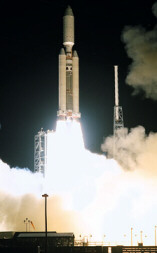 The
Titan 3C was 39 metres high, powered by liquid fuel with two lateral solid
strap-on solid-fuel engines.
The
Titan 3C was 39 metres high, powered by liquid fuel with two lateral solid
strap-on solid-fuel engines.
 The
Titan 3C was 39 metres high, powered by liquid fuel with two lateral solid
strap-on solid-fuel engines.
The
Titan 3C was 39 metres high, powered by liquid fuel with two lateral solid
strap-on solid-fuel engines.
Solid-fuel Rocket Engines
The first solid-fuel rocket engines were first invented hundreds of years ago in China. In the US National Anthem, written in the early 1800's, "the rocket's red glare" refers to small military solid-fuel rockets with payload of bombs or incendiary devices.
This old idea also has low cost, and is comparatively easy to implement. Compared to a liquid-propellant rocket, a solid-propellant rocket has fewer parts, simpler construction, is safer and more reliable, and yet it can develop greater power (thrust) than a liquid-propellant rocket of the same size. The drawback is that once the fuel is ignited, like a 4th of July bottle rocket, it can no longer be freely turned on or off - so guidance and control are comparatively difficult.
The Titan 3C rocket uses solid fuel rocket engines for the initial huge thrust upon launch, followed by additional stages with the more versatile liquid fuel engines with more control.
The idea behind a simple solid-fuel rocket is straightforward, based on using a fuel and that burns very quickly, but without explosion. The propellant is a mixture of ammonium perchlorate (oxidizer, 69.6% by weight), aluminum (fuel, 16%), iron oxide (catalyst, 0.4%), held together by a polymer binder (12.04%, and an epoxy curing agent (1.96 percent).
This mixture is in the long cylindical casings, strapped each side of the other three stages of the rocket. As it burns from the bottom up, the propellant is packed in different shapes. It gives a high thrust for the first 50 seconds after ignition and then, to reduce structural stress, burns more slowly after lift-off, giving about one-third of the original thrust for the rest of its total of about 2 minute duty.
 In
the forward motor section, before ignition, the propellant has a hollow
tube-like core in the shape of an 11-point star. The cross-section diagram
shows the fuel in green. Notice the additional surface area exposed by
this shape, to involve more fuel in the initial greater thrust on launch.
The fuel burns along the inside wall of the hollow core outwards to the
casing. More than a million pounds of fuel burns out in about two minutes!
In
the forward motor section, before ignition, the propellant has a hollow
tube-like core in the shape of an 11-point star. The cross-section diagram
shows the fuel in green. Notice the additional surface area exposed by
this shape, to involve more fuel in the initial greater thrust on launch.
The fuel burns along the inside wall of the hollow core outwards to the
casing. More than a million pounds of fuel burns out in about two minutes!
The Titan 3C rocket
In the Titan 3C rocket design, after the solid-fuel rocket engines alone provided the initial take off thrust, there were three more stages with liquid-fuel engines. It was the first rocket to fire 4 times during a flight.
The Titan launch vehicle family was developed by the United States Air Force to meet its medium lift requirements in the 1960's. The solid-fuel motor segment used was tested 5 August 1961.
The Titan 3C rocket was first launched 18 June 1965 from Cape Canaveral, Florida with a payload mass of 9,694 kg. The Titan evolved through several designs. Titan 3C was made of the 3 stages of Titan 3A plus two lateral solid boosters of 3.1 m diameter. At 25.5 m high and 250 tons, each (composed of 5 segments) provided 5340 kN thrust.
"Transtage"
was the name given to the final stage, which contained the full command
module of the vehicle including the guidance system. Titan IIIC/Transtage,
with other various upper stages, achieved greater mission and flight plan
flexibility. Transtage was designed, developed, and built for a variety
of space operations. It incorporates guidance,attitude control, structures,
thermal control, tracking, power, instrumentation, propulsion, range safety,
retrorockets, and payload delivery subsystems. This flexible space system
has carried out missions involving ballistic, low-orbit insertion, synchronous
equatorial orbit insertion, orbit trim, orbit transfer, orbital plane change,
and multiple payload separation maneuvers.
 |
| The Cassini spacecraft was successfully launched from Cape Canaveral, Florida aboard an Air Force Titan IVB/Centaur rocket, 15 October 1997. (source) |
From 1965 to 1982 the Titan 3C was used to launch unmanned military payloads directly into orbit - up to 12 ton heavy photoreconnaisance platforms) in low earth orbit (LEO) or 1 ton communications or missile launch detection satellites in a higher geostationary earth orbit (GEO). After this generation of Titan rockets, the family continues to evolve, with use planned into the 21st century.
After NASA junked their own Saturn launch vehicle family in the mid-1970's, and the Challenger disaster in the 1980's, Titans were used for launching NASA deep-space probes. Whatever trouble NASA managed to get itself into, the Titan was still there to keep its planetary exploration program going.
LINKS:
Visit this encylopedic site if you are hungry for detailed statistics on each stage of the Titan 3C.
A large photograph of the launch of a Titan 3C - but it is the last to load of several other huge pictures, so plan a coffee break when you visit.